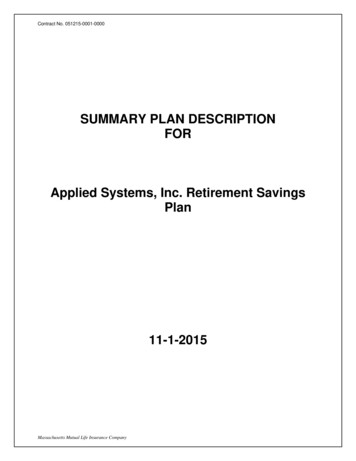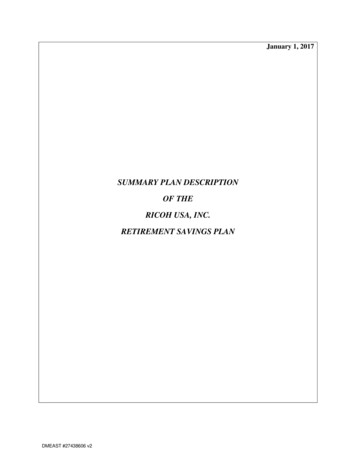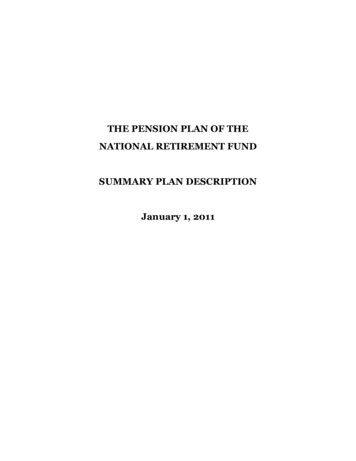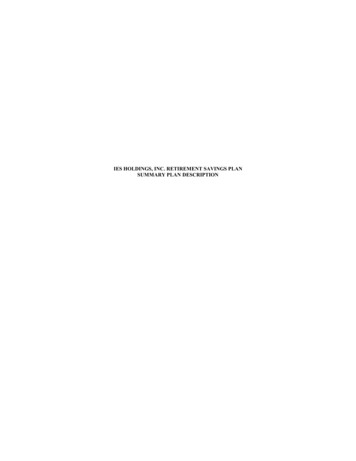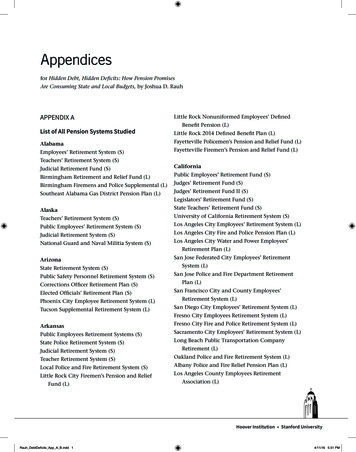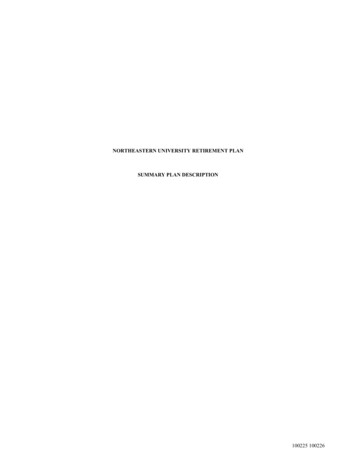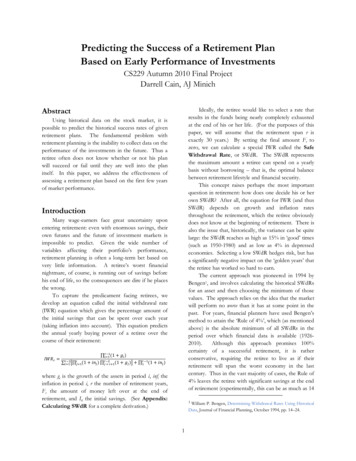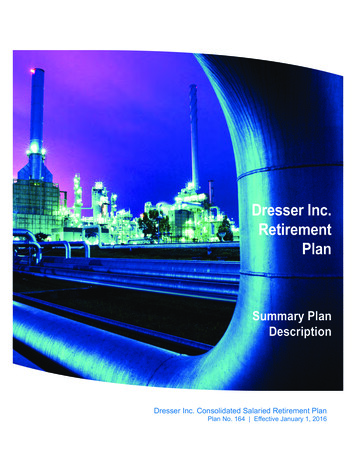
Transcription
Dresser Inc.RetirementPlanSummary PlanDescriptionDresser Inc. Consolidated Salaried Retirement PlanPlan No. 164 Effective January 1, 2016
Plan 164INTRODUCTIONThe Dresser Inc. Consolidated Salaried Retirement Plan (the “Plan”) is designed tocontinue a portion of your monthly income after your working years with Dresser. The benefitsyou receive from the Plan, combined with Social Security, your personal savings, and othersources of income, can help you enjoy a financially secure retirement. The Plan may also providea lifetime income to your surviving spouse in the event of your death after you are vested in yourbenefits.Dresser is proud to sponsor this Retirement Plan for all eligible employees. The Companypays the full cost of the Plan; you are not required to make any contributions.Since the Plan is a critical part of your future security, it’s important for you tounderstand how it works. This booklet, called a Summary Plan Description (SPD), is a brief andgeneral description of the Plan. The SPD describes who is eligible for benefits; how your benefitis determined; when that benefit is payable to you; how it is paid; what your rights are under thePlan; and when you may lose or forfeit benefits. If you have any questions about the Plan or theway it works, contact your Personnel Office.The Plan document contains all the detailed provisions governing the benefits providedunder the Plan. Therefore, the benefits actually provided by the Plan will be controlled by theprovisions in the Plan document, which may be amended at any time. In case of any conflictbetween this Summary Plan Description and the official Plan document, the Plan document willgovern. Participants and beneficiaries should not rely on any oral description of the Plan; thewritten terms of the Plan will always govern.The providing of this Pension Plan does not imply that employment is guaranteed for anyperiod of time. Nothing in this Plan will be deemed to give any participant, former participant,or spouse an interest in any specific trust assets or any other interest, except the right to receivebenefits according to the provisions of the Plan.The Plan was frozen effective as of May 31, 1995. This means that the accrued benefit ofany participant is limited to the accrued benefit as of May 31, 1995. This also means thatincreases in remuneration after May 31, 1995 will not be recognized in computing benefits underthe Plan, and that credited service will not be earned for any periods of employment afterMay 31, 1995, except that service after May 31, 1995 will continue to count as vesting service.In addition, no one may become a participant after May 31, 1995.Effective April 30, 2003, this Plan was merged with the plans listed in Appendix B(“Merged Plans”). The benefits provided to participants in the Merged Plans continue to bedetermined in accordance with the terms of the applicable individual plan and are described inthe SPD for the applicable individual plan. This merger did not increase or decrease benefitsunder this Plan or the Merged Plans.2
Plan 164On February 1, 2011, Dresser Inc. was acquired by the General Electric Company (GE).The Plan continues to be sponsored by Dresser, Inc. and administered by the Dresser, Inc.Employee Benefits Committee. However, as of February 1, 2011, GE and its affiliates havebecome “associated companies” of Dresser, Inc. for certain purposes under the Plan, includingthe determination of Vesting Service.This booklet generally describes the Plan as of January 1, 2016. This booklet alsoincludes information about certain prior Plan provisions. If this summary refers to a provision ofthe Plan which is only effective before or after a certain date, that date will be noted. Thebenefits you accrue under the Plan and the rules governing those benefits may change from timeto time.GENERAL INFORMATIONPlan Name:Dresser Inc. Consolidated Salaried Retirement Plan.Employer Identification:75-2795365Plan Number:The number assigned for government reporting purposes is164Funding Medium:The assets of the Plan are held in the GE Pension Trust.The trustees for the General Electric Pension Trust are allofficers of GE Asset Management Incorporated. As ofMarch 19, 2015, the trustees are George A. Bicher, Paul M.Colonna, Gregory B. Hartch, Ralph R. Layman, Matthew J.Simpson, Dmitri L. Stockton, Donald W. Torey, David W.Wiederecht and Matthew J. Zakrzewski. All of the trusteescan be contacted at: GE Asset Management Incorporated,1600 Summer Street, Stamford, CT 06905.Contributions:The cost of this Plan is paid entirely by the Company. TheCompany cost is determined from an actuarial valuationmade by an independent actuarial firm. All contributions bythe Company are conditioned upon their being deductiblefor federal income tax purposes.Type of Plan:The Plan is a “defined benefit” plan under the EmployeeRetirement Income Security Act of 1974 (ERISA). Thismeans that the benefit you receive at retirement isdetermined according to the provisions of the Plan, and isnot influenced by investment performance. Unlike adefined contribution plan, no funds are held in an individualaccount for any participant.3
Plan 164Plan Sponsor andAdministrator:The Plan sponsor is Dresser, Inc. (the “Company”). Theplan administrator is the Dresser, Inc. Employee BenefitsCommittee (the “Committee”). You may reach both theCompany and the Committee at:Dresser, Inc. Employee Benefits Committee6860 North Dallas Parkway, Suite 800Plano, Texas 750241-866-325-8214The Company and the Committee have the right to amend,modify or terminate the Plan at any time.Persons Designated forService of Legal Process:Dresser, Inc.c/o GE Oil & Gas Affiliate Employee Benefits COE6860 North Dallas Parkway, Suite 800Plano, Texas 75024Legal process may also be served upon the PlanAdministrator or Trustee.Plan Year:The Plan Year begins on January 1 and ends on December31. Prior to the Plan Year beginning January 1, 2016, thePlan used a Plan Year beginning on May 1 and ending onApril 30.Effective Date:The provisions described in this Summary Plan Descriptionare effective from January 1, 2016.4
Plan 164WHO IS ELIGIBLEYou are eligible to participate in this Plan if you were entitled to a benefit under the Planas of April 10, 2001. On that date, Dresser assumed sponsorship of the Plan and assumedresponsibility for providing any benefits under the Plan. Benefits are also provided from thisPlan for certain periods of service with companies that were acquired by Dresser.The Plan was frozen effective as of May 31, 1995. This means that no one was eligible tobecome a participant in the Plan after May 31, 1995.The eligibility provisions for each of the Merged Plans can be found in the most recentlypublished summary plan description for the plan. All of the Merged Plans were also frozen as ofthe time they were merged into this Plan, and therefore no one is eligible to become a newparticipant under the provisions of any Merged Plan.You cannot participate in the Plan if you are an active participant in another tax-qualifiedpension plan of Dresser or an affiliated company. Of course, if you participate in a 401(k) plan,you may also participate in this Plan, unless specifically excluded under terms of this Plan.TERMS YOU SHOULD KNOWTo understand how the Plan works, you will need to be familiar with certain specificterms. The following definitions should be helpful to you as you read this booklet, since theterms defined are used to explain how your benefits under the Plan are calculated.For definitions and rules concerning benefit calculations under the Merged Plans, see themost recently published summary plan description for each plan.Covered CompensationCovered Compensation is a term related to Social Security used in calculating a portionof your retirement benefit. Covered Compensation is the monthly average of the Social Securitywage base (the maximum earnings on which you pay Social Security taxes each year) in effectfor each calendar year during the 35-year period ending at your Social Security retirement age.You can find your Social Security retirement age from the following table.Social Security Retirement Age (SSRA)Date You Were BornBefore 19381938 Through 19541955 and After5SSRA656667
Plan 164A table of Covered Compensation for benefits calculated in 1993 is included as AppendixA. The table changes every year as the Social Security wage base goes up.Credited ServiceYou receive credit under the Plan for certain years of service with the Company. This“Credited Service” is used to calculate the amount of your Plan benefits. In general, the moreyears of Credited Service you have, the larger your Plan benefits will be. Credited Serviceusually starts when your employment begins. Credited Service stops for all Participants as ofMay 31, 1995, the date on which the Plan was frozen. Credited Service does not include:·Periods before May 1, 1986, when you did not contribute to the Dresser RetirementIncome Plan (the Prior Plan) for any reason except disability;·Service before joining the Prior Plan (or such other plan), if you did not join the PriorPlan or any plan of an acquired company at the earliest possible date, where servicewould otherwise be counted;·Service with a company prior to its acquisition if the acquisition was on or after March 1,1972;·Authorized leaves of absence that began before March 1, 1986 (for an authorized leave ofabsence that began on or after that date, only periods of leave greater than 12 months areexcluded from Credited Service);·Layoffs·Periods of employment before taking a position covered by the Plan; and·Periods before May 1, 1986 if you were Age 60 or older at the time.Final Average Monthly EarningsYour Final Average Monthly Earnings are your Pensionable Earnings over a five-yearperiod. To calculate your Final Average Monthly Earnings, you must count the five consecutivecomplete calendar years, out of your last ten complete calendar years, in which your earningswere highest. In this calculation, the year in which you terminate employment is considered acomplete year, so you will be selecting your years of highest earnings from up to eleven years.To figure your Final Average Monthly Earnings, add the five years of highest earningsand divide the total by 60 to get your monthly average.If you have fewer than five complete calendar years from which to choose, yourPensionable Earnings are divided by your months of service.6
Plan 164Inflation-Proofing FactorThe benefits you accrued under the Plan through April 30, 1989, are calculated and fixed(in doing so, the Plan actually enhances these benefits). Then, to help protect your benefit fromthe impact of inflation, the Plan uses what is called an Inflation-Proofing Factor. When youterminate or retire, this factor will be determined by dividing your Final Average MonthlyEarnings when you leave Dresser by your Final Average Monthly Earnings at April 30, 1989.Here is an example of how the Inflation-Proofing Factor works:The Final Average Monthly Earnings on the date the employee retires is 4,000.The Final Average Monthly Earnings at April 30, 1989, is 3,500. Therefore, theInflation-Proofing Factor is 4,000 divided by 3,500 1.142857.Military ServiceBoth your Vesting Service and Credited Service include military service (voluntary orinvoluntary) for up to one year. If you do not return to the Company by then, your militaryservice will be counted only if you meet the following conditions:·You receive an honorable release or discharge from the military; and·You are reemployed within 90 days of discharge from active duty and return toemployment with Dresser or a related company.Pensionable EarningsYour Pensionable Earnings are your earnings from the Company that are used incalculating your retirement benefit from this Plan. The amount of your benefit depends on yourearnings, as well as your Credited Service. Generally, the higher your earnings, the higher yourpension benefit.Your Pensionable Earnings Include:· Base salary, including- 401(k) deferrals- Salary reductions for theBenefitsPay Plan· Overtime·Your Pensionable Earnings Do Not Include:·Cash amounts received from theBenefitsPay PlanNon-deferred bonuses paid in thecalendar year7·Education allowances·Parking allowances
Plan 164·Short-term deferred compensationpaymentsForeign service allowance·Deferred bonuses··Severance pay while on leave ofabsence·Amounts related to exercise of stockoptionsPayments under a performanceunit/share plan or incentive·Gain sharing payments·Profit-sharing payments·Before 1992, non-deferred bonuses accrued for the Company’s fiscal year ending inthe calendar year.·Federal tax laws limit the amount of compensation that can be included in your earningsfor any one calendar year. The limits for years before 1990 and for later years are:Annual Limit on Pensionable EarningsYearLimitBefore 012002 200,000 209,200 222,220 228,860 235,840 150,000 150,000 150,000 160,000 160,000 160,000 170,000 170,000 200,000 IndexedBefore May 1, 1989, the amount of compensation that could be counted in PensionableEarnings was unlimited. So that participants do not lose benefits accrued through May 1, 1989,the Plan preserves these benefits based on unlimited Final Average Monthly Earnings (explainedin the next section) as of that date.8
Plan 164Primary Social Security BenefitsThe Plan formula for calculating your retirement benefit uses your Primary SocialSecurity benefit for part of the calculation. This figure is the retirement benefit that you are, orwill be, entitled to receive at age 65 under the Social Security program, assuming your 1988earnings continue until age 65. (For this calculation, the Plan uses the Social Security law of1989.)ReemploymentAfter you are reemployed by the Company, your Vesting and Credited Service aregenerally determined by combining your prior period of service with your service afterreemployment. But if you leave and are reemployed within twelve months, your time awaycounts as Vesting Service but not Credited Service.If you are gone more than twelve months, then you will not receive any Vesting orCredited Service for the period between your severance and rehire. If you received a lump-sumdistribution when you terminated your employment, your Plan benefit when you retire will bereduced accordingly -- unless you repay your prior distribution, with interest, within five years ofreemployment.Your original period of employment will count as Vesting Service or Credited Service onlyif: You had a vested benefit under the Plan when your employment terminated; You were not gone longer than your original period of employment; or Your absence was less than five years.If your absence began before May 1, 1985, other rules may apply.ServiceYour length of service with the Company helps determine both your eligibility forbenefits and the amount of your benefits.Severance From Service DateYour Credited Service and Vesting Service end on your Severance From Service Date,which is the date on which you are no longer employed because you quit, retire, are discharged,or die. If you are away from work for any other reason, except total disability, your SeveranceFrom Service Date will be the latest of:9
Plan 164·One year after you leave work without pay;·Two years, if your absence is for maternity or paternity leave, and you come back towork within that period; or·The last day for which you are paid.For authorized leaves of absence after February 28, 1986, the Severance-From-ServiceDate will be the last day of your authorized leave.Transfer InIf you transfer to a position with Dresser that is covered by this Plan from a position thatis not covered (for example, you transfer from a subsidiary or joint venture not covered, or fromhourly paid status), your prior service will count in Vesting Service and toward Plan eligibility. Itwill not count as Credited Service. If you transferred from hourly service before June 20, 1974,however, your hourly service will be counted as Credited Service as well.If you were a participant in the Dresser Canada, Inc. Retirement Income Plan and transferto the U.S. and become a participant in this Plan, your Canadian service will be counted underthis Plan. All of your benefits will then come from this Plan; you will receive no benefits fromthe Canadian plan.Transfer OutIf you are participating in the Plan and transfer your employment to a Dresser operation,subsidiary, or joint venture that does not participate in the Plan, your benefits accrued to the dateof your transfer will be calculated and frozen. But your future service with the other Dresseroperation, subsidiary, or joint venture will be counted as Vesting Service under the Plan. Thismeans that if you terminate or retire after you transfer, you could be eligible to receive benefitsunder this Plan for your service before your date of transfer, plus benefits under the plan of theother Dresser operation or joint venture for your service after your transfer.If you are not a U.S. citizen and not a resident alien in the U.S., and you are transferred toDresser Canadian operations, your benefits will be paid entirely from the Canadian plan. Nobenefits will be payable from this Plan.10
Plan 164Vesting ServiceVesting Service is used to determine whether you have a right to a benefit under the Plan,and if so, when you may receive it. Generally, your Vesting Service starts when youremployment begins, and ends when your employment ends. It may or may not be the same asyour years of Credited Service.The following periods of employment do not count toward your Vesting Service:·Any leave of absence before May 1, 1976;·Any periods during which you were eligible to make contributions to the Prior Plan anddeclined to do so; and·Periods of service of more than one year before joining the Prior Plan (or such otherplan), if you did not join the Prior Plan or any plan of an acquired company at the earliestpossible date, where service would otherwise be counted.Except for any leaves of absence before May 1, 1976, your Vesting Service includes timeduring any authorized leave of absence. Vesting Service also includes your service as part ofDresser’s controlled group of companies and related companies, even though your position maynot be eligible for participation in the Plan. Special rules for the crediting of Vesting Servicemay also apply to employees affected by certain corporate sales and dispositions of formerDresser businesses.11
Plan 164YOUR BENEFITS UNDER THE PLANThe Plan is designed to begin paying benefits at normal retirement, which is age 65. Butthe Plan also allows benefits to be paid at late or early retirement. This section explains whenyou can receive these benefits and how much the Plan pays.For benefit calculation and payment rules applicable to the Merged Plans, see the mostrecently published summary plan description for each plan.Normal or Late Retirement BenefitsYour Normal Retirement Date is the first of the month on or after your 65th birthday.You must have at least five years of Vesting Service to begin receiving your benefit. If you donot have five years of service when you reach age 65, you must complete five years before youwill be eligible for benefits. Your benefits will not begin until after you retire.Your Late Retirement Date is the date you actually retire after continuing to work withDresser beyond your Normal Retirement Date. By law, though, you must begin receivingbenefits no later than the April 1 of the year after the calendar year in which you reach age 701/2.Calculating Your BenefitCalculating your benefit under this Plan is a complex process. It involves separatecalculations for three periods of service:Periods of Service Used in the FormulaThe first period of service ends on April 30, 1986, and the second period runs from May1, 1986 to April 30, 1989. The third period is for service after April 30, 1989. Of course, if youwere employed after April 30, 1989, then only the explanation for service after that date isapplicable to you. The formulas for each of the service periods shown in the chart are describedbelow. Examples are provided to show how benefits are calculated for each period of service.Each example is based on a number of assumptions, as outlined in a chart on the next page.12
Plan 164Example: Retires At Age 65 on December 1, 1995, With 27 Years of Service(1)(2)(3)(4)(5)(6)FinalAge 86 3,0004/30/89 3,500 80012/1/93 4,000As shown on annuity ervice at Datein Column (1) 2,15017.416720.416727.0000Prior PlanAccruedBenefit* 850Periods of Service Used in the FormulaPriorplanservice 5/1/86Newplanservice 5/1/89Postplan-changeservice The Formula for Prior Plan ServiceHere are the steps you must take to calculate your benefit for Prior Plan Service, which isyour service before May 1, 1986.1. Take 2% of your Final Average Monthly Earnings at April 30, 1989. Subtract 1.59% of yourSocial Security Benefit (based on the law in effect April 30, 1989).(.02 x 3,500) - (.0159 x 800) 57.282. Multiply this amount times your Credited Service before May 1, 1986. 57.28 x 17.4167 997.633. Multiply this amount times the Inflation-Proofing Factor. 4,000 / 3,500 (that is 1.142857) x 997.63 1,140.154. Then, to determine your benefit for Prior Plan Service, subtract the benefit that waspurchased from the Prudential Insurance Company. In this example, the benefit was 850,which is the benefit accrued under the Prior Plan at April 30, 1986. 1,140.15 - 850 290.1513
Plan 164Note: The benefit purchased from Prudential will be paid in addition to the benefit youreceive from this Plan by Prudential.The Formula for New Plan ServiceAs shown in the diagram above, New Plan Service is from May 1, 1986, through April30, 1989. Here are the steps involved in calculating your benefit for New Plan Service.1. Take 1.5% of your Final Average Monthly Earnings at April 30, 1989. Subtract 1.43% ofyour Social Security Benefit (based on the law in effect on April 30, 1989).(.015 x 3,500) - (.0143 x 800) 41.062. Multiply this amount times credited service between May 1, 1986 and April 30, 1989. 41.06 x 3.0000 123.183. Multiply this amount times the Inflation-Proofing Factor. 4,000 / 3,500 (that is 1.142857) x 123.18 140.78The monthly benefit for the three years of New Plan Service is 140.78.The Formula for Post Plan-Change ServiceYour Post Plan-Change Service is service after May 1, 1989. The Post Plan-Changeformula is explained in the following chart:Post Plan Change ServiceFinal Average Monthly Earnings0.85%0.75%, 0.70%, or 0.65%Social SecurityBased on Social SecurityRetirement Age**see the table belowCovered Compensation14
Plan 164Percentage Tied ToSocial Security Retirement Age (SSRA)Date You Were BornSSRAPercentBefore 19381938 Through 19541955 and After6566670.75%0.70%0.65%In determining your Post Plan-Change Service, the formula takes 0.85% of Final AverageMonthly Earnings up to Covered Compensation. Then, as the chart shows, a different percentageis applied to Final Average Monthly Earnings above Covered Compensation.The following steps are required to calculate your benefit for Post Plan-Change Service:1. Calculate the benefit based on Final Average Monthly Earnings up to CoveredCompensation. As shown in the chart, the benefit percentage is 0.85% times Final AverageMonthly Earnings up to Covered Compensation. This amount must then be multiplied byCredited Service from May 1, 1989. Using the data from the example on page 14, thecalculation is as follows:.0085 x 2,150 x (27.0000 - 20.4167) 120.312. Next, figure the benefit on Final Average Monthly Earnings above Covered Compensation.Since the employee in the example reaches age 65 in 1995, the date of birth was 1930.Therefore, the percentage to use is 0.75%. Multiply 0.75% times Final Average MonthlyEarnings above the Covered Compensation level. Multiply that amount times CreditedService from May 1, 1989, as follows:.0075 x ( 4,000 - 2,150) x (27.0000 - 20.4167) 91.343. Add the portion of the benefit based on Final Average Monthly Earnings up to CoveredCompensation to the benefit based on Final Average Monthly Earnings above CoveredCompensation. 120.31 91.34 211.65Adding Up Your Total BenefitThe final step in calculating your total benefit from the Plan is to add the benefitscalculated for each of your periods of service.15
Plan 164The Final Step, Putting the PiecesTogetherPrior Plan Service is 1,140.15New Plan Service benefit of 140.78Post Plan Change Service benefit of 211.65The total pension is 1492.58Service Under Plans Acquired by DresserYou may be eligible for benefits under plans in effect before acquisition by Dresser.(Your benefits under those plans will be calculated under their specific plan formulas.) Butbenefits for all service prior to May 1, 1989, may not exceed the benefit calculated as if all ofyour service had been covered under the Dresser plan.EARLY RETIREMENTEligibilityIf you began participating in this Plan on or after May 1, 1986, you can retire early(before age 65) and start drawing a benefit, if you meet the following requirements:·You have at least ten years of Vesting Service, and·You are at least 55 years old.If you began participating in the Prior Plan before August 1, 1983, you do not have tomeet the ten-year service requirement. If you began participating between August 1, 1983, andMay 1, 1986, you need only five years of Vesting Service.When Benefits BeginUsually, early retirement benefits start on the first day of the first month after youterminate employment and elect to retire. But, if you prefer, you may retire before age 65 andelect to receive your benefits later.The following section describes how your early retirement benefit is calculated. If youelect to have benefits start later, your early retirement benefit will be increased by an amountbased on your early retirement age and your age when benefits begin. (This actuarial factor isexplained in the Deferred Early Retirement Benefits section of this booklet).16
Plan 164Calculating Your Early Retirement BenefitsIf you start receiving benefits before age 65, the amount you receive is usually less than itwould be if you retired at age 65. Your early retirement benefit is lower because:·Fewer years of Credited Service are used in the calculation (since you are not with theCompany as long);·Your Final Average Monthly Earnings are usually not as large (because you will not havethe pay increases you might have received in the years between your retirement and age65); and·Under the Plan, benefits are reduced (using early retirement reduction factors) to reflectbenefit payments for more years after retirement.Your early retirement benefit is calculated like your normal retirement benefit, using thedifferent formulas for each period of service. Then, early retirement reduction factors areapplied. These factors also vary, depending on the period of service to which they are applied.The following table shows the early retirement reduction factors.Early Retirement FactorsAge Benefits Start6564636261605958575655New Plan &Post PlanChange ServicePrior Plan ServicePrior Plan ServiceFor Final Average Social Security 567.533.500
Plan 164The following example illustrates how early retirement benefits are calculated. Thisexample assumes that the employee retires early at age 60. It is based on the data from thefollowing table:(1)Date4/30/864/30/8912/1/93Example: Retires Early at Age 60 on December 1, 1995(2)(3)(4)(5)Final AverageMonthlyEarnings 2,500 3,000 3,500Age 65MonthlySocialSecurityMonthlyCoveredCompensation 750 1,000CreditedService at DateIn Column (1) 2,85012.416715.416722.0000(6)Prior PlanAccruedBenefit 430Calculating Your Early Retirement Benefit for Prior Plan ServiceHere are the steps involved in calculating your early retirement benefits for Prior PlanService (service before May 1, 1986).1. Take 2% of Final Average Monthly Earnings at April 30, 1989. Multiply this amount timesthe early retirement factor for “Prior Plan Service for Final Average Earnings” from the tableon page 16.(.02 x 3,000) x .85 51.002. Multiply 1.59% times the Age 65 Social Security Benefit (based on the law in effect on April30, 1989). Multiply that number times the early retirement factor for “Prior Plan Service forSocial Security Offset” from the table on page 17.(.0159 x 750) x .667 7.953. Subtract Step 2 from Step 1 and multiply the difference times Credited Service before May 1,1986.( 51.00 - 7.95) x 12.4167 534.544. Multiply the result of Step 3 times the Inflation-Proofing Factor. 3500 / 3,000 (that is 1.166667) x 534.54 623.635. To determine your benefit from this Plan, you must then subtract the benefit that waspurchased from the Prudential Insurance Company. In this example, that benefit was 430(the benefit accrued under the Prior Plan at April 30, 1986). 623.63 - 430 193.6318
Plan 164Note: The benefit purchased from Prudential will be paid in addition to the benefit youreceive from this Plan by Prudential.Calculating Your Early Retirement Benefit for New Plan ServiceHere are the steps you must take to calculate your early retirement benefit for New PlanService (service from May 1, 1986, through April 30, 1989).1. Take 1.5% of Final Average Monthly Earnings at April 30, 1989. Subtract 1.43% of theSocial Security Benefit (based on the law in effect on April 30, 1989).(.015 x 3,000) - (.0143 x 750) 34.282. Multiply this amount times credited service between May 1, 1986 and April 30, 1989. 34.28 x 3.0000 102.843. Multiply the result of Step 2 times the early
The Plan sponsor is Dresser, Inc. (the "Company"). The plan administrator is the Dresser, Inc. Employee Benefits Committee (the "Committee"). You may reach both the Company and the Committee at: Dresser, Inc. Employee Benefits Committee 6860 North Dallas Parkway, Suite 800 Plano, Texas 75024 1-866-325-8214
